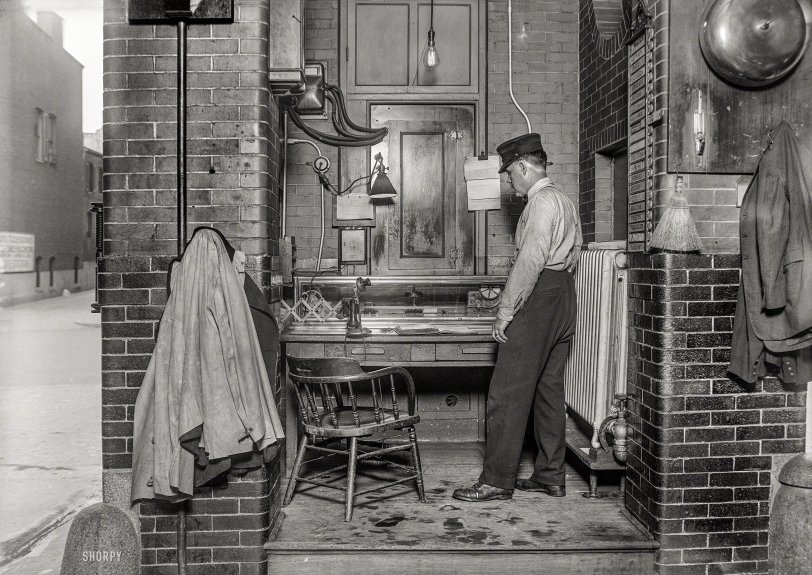


Framed or unframed, desk size to sofa size, printed by us in Arizona and Alabama since 2007. Explore now.
Shorpy is funded by you. Patreon contributors get an ad-free experience.
Learn more.

- Baldwin 62303
- Baldwin VO-1000
- Cold
- No expense spared
- Tough Guys
- Lost in Toyland
- And without gloves
- If I were a blindfolded time traveler
- Smoke Consumer Also Cooks
- Oh that stove!
- Possibly still there?
- What?!?
- $100 Reward
- Freeze Frame
- Texas Flyer wanted
- Just a Year Too Soon
- WWII -- Replacing men with women at the railroad crossing.
- Yes, Icing
- You kids drive me nuts!
- NOT An Easy Job
- I wonder
- Just add window boxes
- Icing Platform?
- Indiana Harbor Belt abides
- Freezing haze
- Corrections (for those who care)
- C&NW at Nelson
- Fallen Flags
- A dangerous job made worse
- Water Stop
Print Emporium
Fire Wire: 1922

Washington, D.C., 1922. "No. 12 Engine Company." Note the paper tape reels used for recording location information from "Gamewell boxes," the automatic-telegraph system used by municipal fire alarms. View full size.
Electric meter ID
The rectangular watthour meter at upper left looks like a General Electric Thomson C Series direct current meter, or possibly the Westinghouse CW-6, a clone which appears to have been made under license. So this part of DC had DC power, as many urban cores still did in the 1920s. Electrical wiring of this period is always entertaining. On the one hand, you have circuits in rigid steel conduit, which offers more mechanical protection than most of today's wiring. But then, you also have exposed conductors in "composition loom" between the meter and the site-built (no doubt asbestos-lined) wooden fusebox.
Turnout coat
I like the canvas turnout coat, probably made by the E A Fay company in Massachusetts. They were used up until the 90's when Bunker Gear came into use.
Toasted on one side
One can't be sure without seeing the other side, but judging by the context and the size of the foot valve on that radiator, that's a low pressure steam heating system.
The silver paint often seen on rads was initially a functional rather than an aesthetic choice; a light coloured or metallic paint reduces the amount of radiant heat a rad gives-off. Painting rads silver makes them less efficient radiators, but more efficient convectors, and this supplies more even heat to the room.
Even with reflective paint, this rad would have been uncomfortably close to the desk. Low pressure steam rads typically run at around 190 degrees Fahrenheit. A big rad like that might be welcome in a drafty garage, but I still can't imagine working that close to it.
Details!
I found three things to be very interesting.
1] The bell is really big.
2] His shoes are quite worn.
3] I miss the duty board mounted on the right wall. Those things were very informative.
Seems strange
that it's apparently fully exposed to the elements with no protection available. And even with a radiator that would seem to be rather useless with no way to enclose a heated area.
[The dispatcher's cubicle is facing the into the engine house, which is like a big garage. - Dave]
Lucky Heater
The weather must of been so bad they needed a lucky horseshoe on the radiator pipe to keep the steam flowing for heat.
The tape
That is actually a Gamewell recorder, isn't it? ADT supplied the circuits.
[ADT, a private company, was one of many organizations using this type of equipment. The first fire alarm telegraphs in the District of Columbia were installed in 1864, then replaced in 1875 by a Gamewell system that was updated in 1909. By 1925 the number of Gamewell boxes was 825. According to an article that year in the Washington Post, "Fire-alarm boxes in the District are connected to 40 wire circuits that contain more than 800 miles of wire. The telephone company furnishes the municipal government with space in its underground conduit system for fire and police wires." - Dave]
Joker Tape.
When I joined the Fire Dept. in DC in 1964 they were still using the paper tape reels. It was called the Joker Tape.
The alarms came in over the Vocalarm, but if you wanted to check the box number you could go to the joker tape.
As Probationary Firemen we were required to memorize the locations of 100 boxes and the 4 closest hydrants.
The probation was for one year, and you got a green book to memorize, word for word. Each month you were tested on it by the Company Captain and every 3 months by the Battalion Chief. At the end of the year you went to the Deputy.
The book contained many rules and regulations, the Boxes, all short streets, and each piece of equipment on the apparatus. Rookies were not allowed TV, Ping Pong, cards or anything else recreational and you spent most of the time on the watch desk. You were never to be caught without your Green Book unless you were working at a fire.
Tincloth needed
You'ld get pretty wet working a shift in blowing rain. Maybe that's why the chair looks so rough.
























On Shorpy:
Today’s Top 5